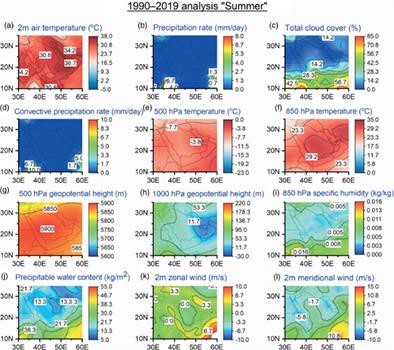当前位置:
X-MOL 学术
›
Int. J. Climatol.
›
论文详情
Our official English website, www.x-mol.net, welcomes your
feedback! (Note: you will need to create a separate account there.)
Seventy-year disruption of seasons characteristics in the Arabian Peninsula
International Journal of Climatology ( IF 3.5 ) Pub Date : 2021-04-29 , DOI: 10.1002/joc.7160 Salah Basem Ajjur 1 , Sami G. Al‐Ghamdi 1
International Journal of Climatology ( IF 3.5 ) Pub Date : 2021-04-29 , DOI: 10.1002/joc.7160 Salah Basem Ajjur 1 , Sami G. Al‐Ghamdi 1
Affiliation

|
Climate change has significantly influenced the characteristics of seasons and negatively affected ecosystems and socio-economic life. This study presents a new, objective definition for seasons in the Arabian Peninsula. Specifically, the study determines disruptions in the onset, cessation, and duration of winter, spring, summer, and autumn based on mean intra-annual changes of 12 climatological parameters from 1950 to 2019. Data for climatological parameters were obtained from the National Centers for Environmental Prediction (NCEP)/National Center for Atmospheric Research (NCAR) reanalysis. These data were analysed using two multivariate statistical methods: principal component analysis and cluster analysis. The results show that the characteristics of the four seasons differ from conventionally defined seasons. The differing characteristics of the four seasons are (a) that winter extends for 91 days, between 2 November (the previous year) and 31 January; (b) spring extends for 111 days, until 22 May; (c) summer extends for 106 days, until 5 September and, finally; (d) autumn completes the cycle, extending for 57 days. To investigate the decadal disruption of seasons' characteristics, the analysis was performed on the data collected during five overlapping 30-year periods: 1950–1979, 1960–1989, 1970–1999, 1980–2009, and 1990–2019. The most remarkable changes were noticed during the last 30 years. Compared to the 70-year analysis, the 1990–2019 analysis showed extra prolongation in the duration of summer and a shortage in winter, which aligns with the recent warming and drying of the Arabian Peninsula. Summer (winter) lasts for 126 (76) days. All analyses propose that all seasons start earlier, compared with the astronomical definition. The findings of this study are key to understanding the consequences of seasons changes in the Arabian Peninsula. These consequences include impacts on agriculture, water deficits, ecosystems, and land cover.
中文翻译:

阿拉伯半岛季节特征的七十年中断
气候变化显着影响了季节特征,并对生态系统和社会经济生活产生了负面影响。这项研究为阿拉伯半岛的季节提供了一个新的、客观的定义。具体而言,该研究根据 1950 年至 2019 年 12 个气候参数的年内平均变化确定了冬季、春季、夏季和秋季的发生、停止和持续时间的中断。环境预测 (NCEP)/国家大气研究中心 (NCAR) 再分析。这些数据使用两种多变量统计方法进行分析:主成分分析和聚类分析。结果表明,四个季节的特征与常规定义的季节不同。四个季节的不同特点是:(a) 冬季在 11 月 2 日(上一年)至 1 月 31 日之间持续 91 天;(b) 春季延长 111 天,直至 5 月 22 日;(c) 夏季持续 106 天,直到 9 月 5 日,最后;(d) 秋季完成循环,延长 57 天。为了调查季节特征的年代际中断,对五个重叠的 30 年期间收集的数据进行了分析:1950-1979、1960-1989、1970-1999、1980-2009 和 1990-2019。最显着的变化是在过去 30 年中注意到的。与 70 年的分析相比,1990-2019 年的分析显示夏季持续时间延长,冬季短缺,这与阿拉伯半岛最近的变暖和干燥相一致。夏季(冬季)持续 126(76)天。所有分析都表明,与天文定义相比,所有季节都更早开始。这项研究的结果是了解阿拉伯半岛季节变化后果的关键。这些后果包括对农业、缺水、生态系统和土地覆盖的影响。
更新日期:2021-04-29
中文翻译:

阿拉伯半岛季节特征的七十年中断
气候变化显着影响了季节特征,并对生态系统和社会经济生活产生了负面影响。这项研究为阿拉伯半岛的季节提供了一个新的、客观的定义。具体而言,该研究根据 1950 年至 2019 年 12 个气候参数的年内平均变化确定了冬季、春季、夏季和秋季的发生、停止和持续时间的中断。环境预测 (NCEP)/国家大气研究中心 (NCAR) 再分析。这些数据使用两种多变量统计方法进行分析:主成分分析和聚类分析。结果表明,四个季节的特征与常规定义的季节不同。四个季节的不同特点是:(a) 冬季在 11 月 2 日(上一年)至 1 月 31 日之间持续 91 天;(b) 春季延长 111 天,直至 5 月 22 日;(c) 夏季持续 106 天,直到 9 月 5 日,最后;(d) 秋季完成循环,延长 57 天。为了调查季节特征的年代际中断,对五个重叠的 30 年期间收集的数据进行了分析:1950-1979、1960-1989、1970-1999、1980-2009 和 1990-2019。最显着的变化是在过去 30 年中注意到的。与 70 年的分析相比,1990-2019 年的分析显示夏季持续时间延长,冬季短缺,这与阿拉伯半岛最近的变暖和干燥相一致。夏季(冬季)持续 126(76)天。所有分析都表明,与天文定义相比,所有季节都更早开始。这项研究的结果是了解阿拉伯半岛季节变化后果的关键。这些后果包括对农业、缺水、生态系统和土地覆盖的影响。











































 京公网安备 11010802027423号
京公网安备 11010802027423号